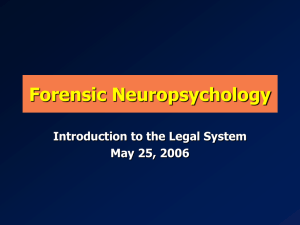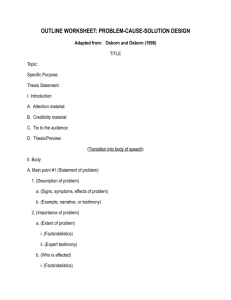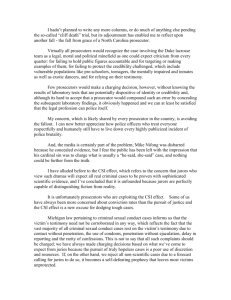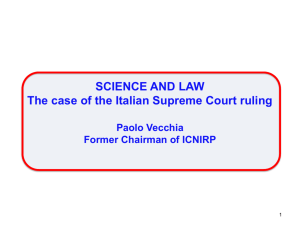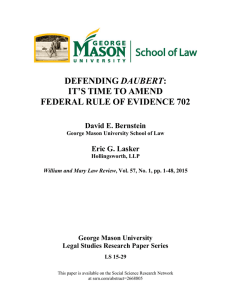forensic_intro_2014
advertisement
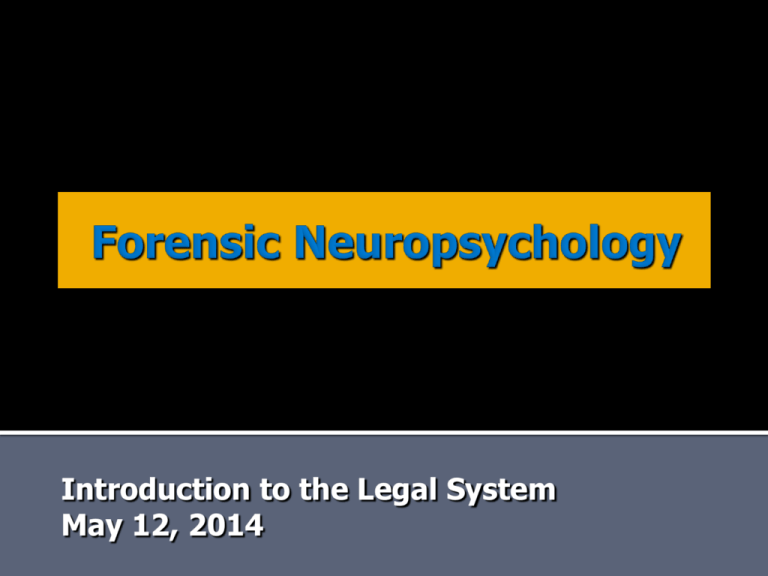
Introduction to the Legal System May 12, 2014 Domains of interaction Competency ▪ Criminal ▪ Civil Criminal responsibility (MSO) Mental injury Profiling, jury selection Juvenile, family matters Mental health professionals as experts Law-mental health organizations American Psychology-Law Society (APA Div. 41) American Academy of Forensic Psychology Training Issues few psychologists with specific legal training few lawyers knowledgeable about psychology Attitudinal Differences emphasis on civil liberties vs. trying to help Free-Will vs. Determinism Simple vs. Multiple Causation Psychologists and attorneys often operate according to different philosophies Psychologists and attorneys frequently use evidence differently Psychologists and attorneys often have different ideas about causation Psychologists and attorneys operate according to different rules Free Will vs. Determinism can’t differentiate behavior which is “forced” or “overborne” vs. freely chosen example: “voluntary” behavior and the law of effect example: “voluntary” intoxication Psychological “proof” is probabilistic, rarely absolute Legal “proof” is probabilistic, then absolute Preponderance of evidence (51%) Clear and convincing evidence (75%) Beyond a reasonable doubt (95%) After burden is met, decision is binary and absolute (absolutely guilty, absolutely liable, etc.) Individual with scientific, technical, or other specialized knowledge or technical who, by nature of knowledge, skill, experience, education, or training is qualified to render opinions (or otherwise) that will assist the trier of fact (i.e., judge, jury) in reaching an appropriate decision in the legal matter at hand. Lay witnesses are allowed to testify only as to their experiences (perceptions, observations, memories). Expert witnesses can testify as to opinions. Expert testimony must be based upon sufficient facts or data the product of reliable principles and methods the product of applying the principles and methods reliably to the facts of the case. Adapted from Federal Rules of Evidence “In this age of science, we must build legal foundations that are sound in science as well as in law. Scientists have offered their help. We in the legal community should accept that offer. We are in the process of doing so.” Associate Justice Stephen Breyer’s “Introduction” in Reference Manual on Scientific Evidence, Second Edition (Federal Judicial Center, 2000) Differences between clinical and scientific “opinions”? Scientific Evidence Standards: 1975: Publication of Federal Rules of Evidence Before 1993: ▪ Frye v. U.S. (1923 Appellate ruling): the “general acceptance” standard (e.g., Newton’s law vs. moon-behavior relationship) After 1993: ▪ “Supreme Court Trilogy: ▪ Daubert v. Merrell Dow Pharmaceuticals (1993)-evidence standards ▪ General Electric Company v. Joiner (1997)-deductive process/relevance ▪ Kumho Tire Co, LTD v. Carmichael (1999)-not just science, but also technical Frye-1: Fundamental scientific principle or discovery Frye-2: The technique used for applying the fundamental scientific principle or discovery Frye-3: The technique’s specific application on which the expert testimony is to be based Reasoning or methodology underlying testimony must be “scientifically valid” Judge as “gatekeeper” “Daubert Criteria” for admissibility ▪ Whether theories or techniques on which testimony rests are based on a testable hypothesis ▪ Whether the theory or technique has been subjected to peer review ▪ Whether the technique has known or potentially known error rate ▪ Whether the method/theory is generally accepted in the scientific community Discussion point: What are the implications of a “generally accepted” standard? What does the “known or potentially known error rate” standard mean? Can we meet it? Reinforced gatekeeper function of trial judge Upheld trial court’s refusal to admit certain testimony because it was not “relevant” Thus, not just reliability, but relevance as a standard “[N]othing in either Daubert or the Federal Rules of Evidence requires a district court to admit opinion evidence which is connected to existing data only by the ipse dixit [personal opinion] of the expert. A court may conclude that there is simply too great an analytical gap between the data and the opinion proffered.” Extended “expert” testimony beyond scientific evidence to all expert testimony based on “skill-experience-based observation” Four Daubert criteria may be relevant, but are not essential; other factors may be operative in the particular case Afterwards, Rule 702 of FRE modified: If scientific, technical, or other specialized knowledge will assist the trier of fact to understand the evidence or to determine a fact in issue, a witness qualified as an expert by knowledge, skill, experience, training, or education, may testify thereto in the form of an opinion or otherwise if (1) the testimony is based upon sufficient facts or data, (2) the testimony is the product of reliable principles and methods, and (3) the witness has applied the principles and methods reliably to the facts in case. Describing behavioral observation (“he was yelling”) Inferring a general mental state (“he appeared agitated”) Fitting the mental state into a theoretical construct (“his behavior was consistent with a dysexecutive syndrome”) Diagnosis (“his behavior suggests a personality change due to organic brain damage in the frontal lobe”) Relating the formulation to legally relevant behavior (“at the time of the offense, he was unable to control his violent impulses”) Elements of the ultimate legal issue (“although he understood right from wrong when the offense committed, he couldn’t control his behavior because of brain damage”) Ultimate legal issue (“he was insane at the time of the offense”) 1) any system of regulations to govern the conduct of the people of a community, society or nation, in response to the need for regularity, consistency and justice based upon collective human experience. “a principle or rule of conduct so established as to justify a prediction with reasonable certainty that it will be enforced by the courts if its authority is challenged” four main elements: rule of conduct enforceable reasonable certainty court system as vehicle for enforcement Constitutional Law: overarching; establishes other types of law; most important constitutional amendments: 5th: privilege against self-recrimination 6th: right to counsel 14th: right to due process under the law Statutory Law: established by legislature (often at state level) some statutes made up by more specialized bodies (e.g., DHHS) Case Law: decisions made by judiciary and used as precedent (e.g., Frye, Dusky) not just interpretation, but makes suggestions (e.g., when law is found unconstitutional) Administrative Law: rules and regulations constructed by executive branch Basic elements: legislature (‘makes law’), executive (‘enforces law’), judiciary (‘interprets law’), but there are exceptions Criminal law: handled by states, unless a federal crime interstate cimes offenses targeting federal official violations of civil rights law offenses on, or involving, federal property Federal Courts Trial court: district court is trial court (N=94) Appellate court: 2 levels: Circuit Court of Appeals (Atlanta; one of 13); US Supreme Court State Judicial System (Florida) Trial court: circuit court is trial court (N=20) ▪ 2 levels of general jurisdiction trial courts (minor, major criminal/civil) ▪ special jurisdiction courts (“juvenile court”, “divorce court”) Appellate court: 2 levels: District Court of Appeals, State Supreme Court County Courts (N = 67) Disputes of $15K or less Criminal vs. Civil: criminal: US/state v. individual civil: individual v. individual (contracts, property, torts, wills) Substantive vs. procedural: substantive: rights, duties/responsibilities procedural: how substantive law is applied Statutory vs. Common statutory: established by legislatures common: established by judges (precedent) “Crime” is any act or omission of an act in violation of a public law Focus on harming public safety/welfare Levels of criminal activity Felony (more serious > 1 year) Misdemeanor (less serious > 5 days) Violation (e.g., traffic) States develop criminal statutes; but there is a “Model Penal Code” (ALI, 1962/1981) Assists states in standardizing penal code Specifies ‘mens rae’ conditions That which is not forbidden is allowed Governs private relationships between members of a community, or the rights of individual, private citizens Civil Commitment Guardianship Wills and probate Tort law Criminal: beyond reasonable doubt; burden on prosecution Civil: preponderance of evidence, burden on plaintiff Administrative: clear and convincing; burden on plaintiff ‘Quasi-Criminal’: involving significant deprivation of liberty (e.g., civil commitment); clear and convincing evidence Understand the legal system Practice good neuropsychology/clinical psychology Adhere to ethical principles Be courtroom familiar/saavy Greiffenstein & Cohen, 2005 Preassessment phase What’s the case about? What’s my role? ▪ Fact witness ▪ Expert witness ▪ Litigation consultant What’s the time-frame? Availability of the plaintiff/defendant? Fee schedule Greiffenstein & Cohen, 2005 Assessment Phase Review of outside records Direct interview Collateral report Neuropsychological testing Specialized testing Greiffenstein & Cohen, 2005 Report-writing Differences between clinical and forensic reports ▪ ▪ ▪ ▪ Focus on legally relevant factors Limit discussion of irrelevant background info Full disclosure of information sources Discriminate opinion/conclusions from facts Key features ▪ Causation analysis ▪ Functional analysis ▪ Accurate attribution of facts Trial Phase Discovery ▪ ▪ ▪ ▪ Interrogatories Affadavits Depositions Records exchange Admissibility (see previous discussion) Deposition/testimony ▪ Qualification ▪ Direct Examination ▪ Cross-Examination Post-Trial Phase Greiffenstein & Cohen, 2005
